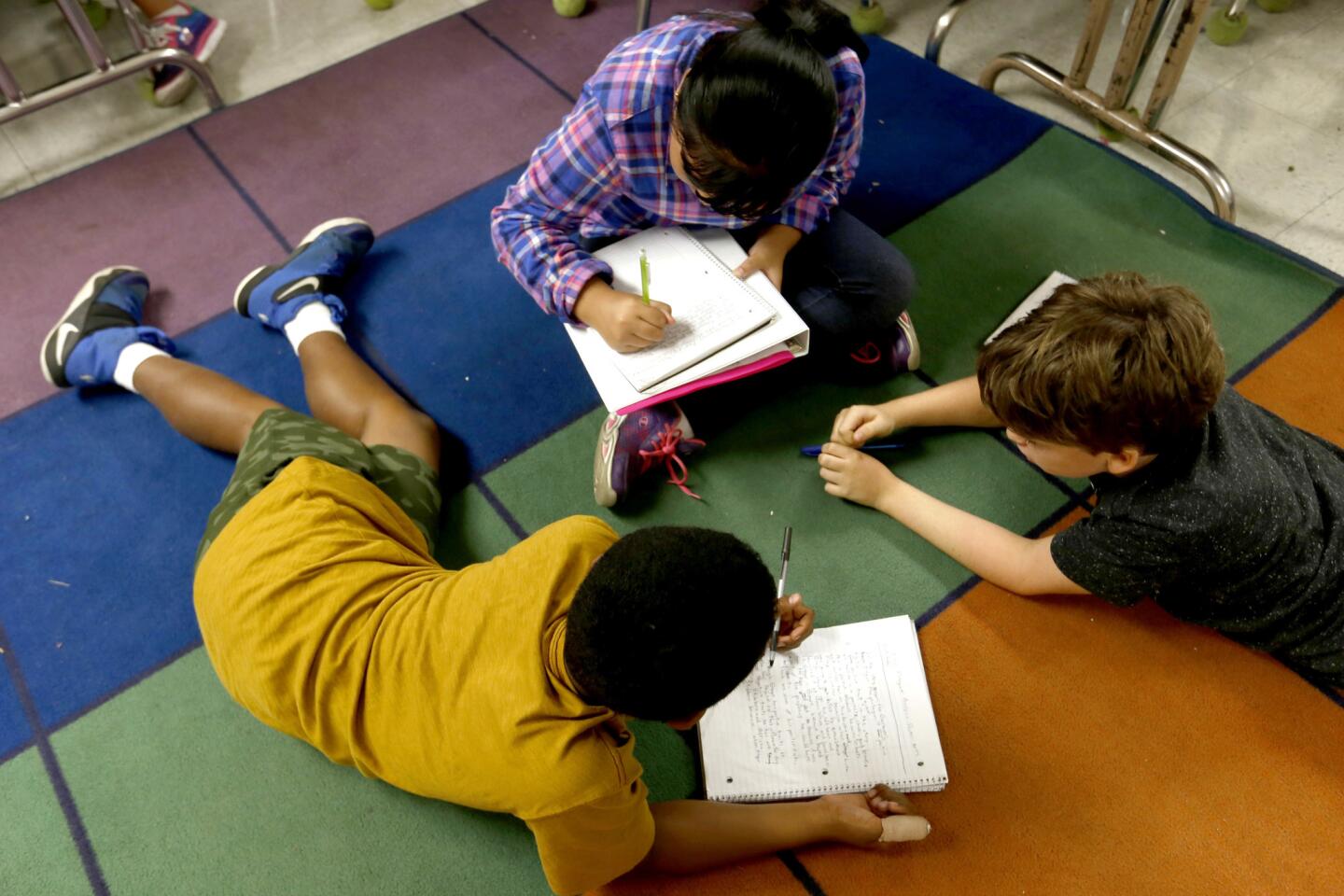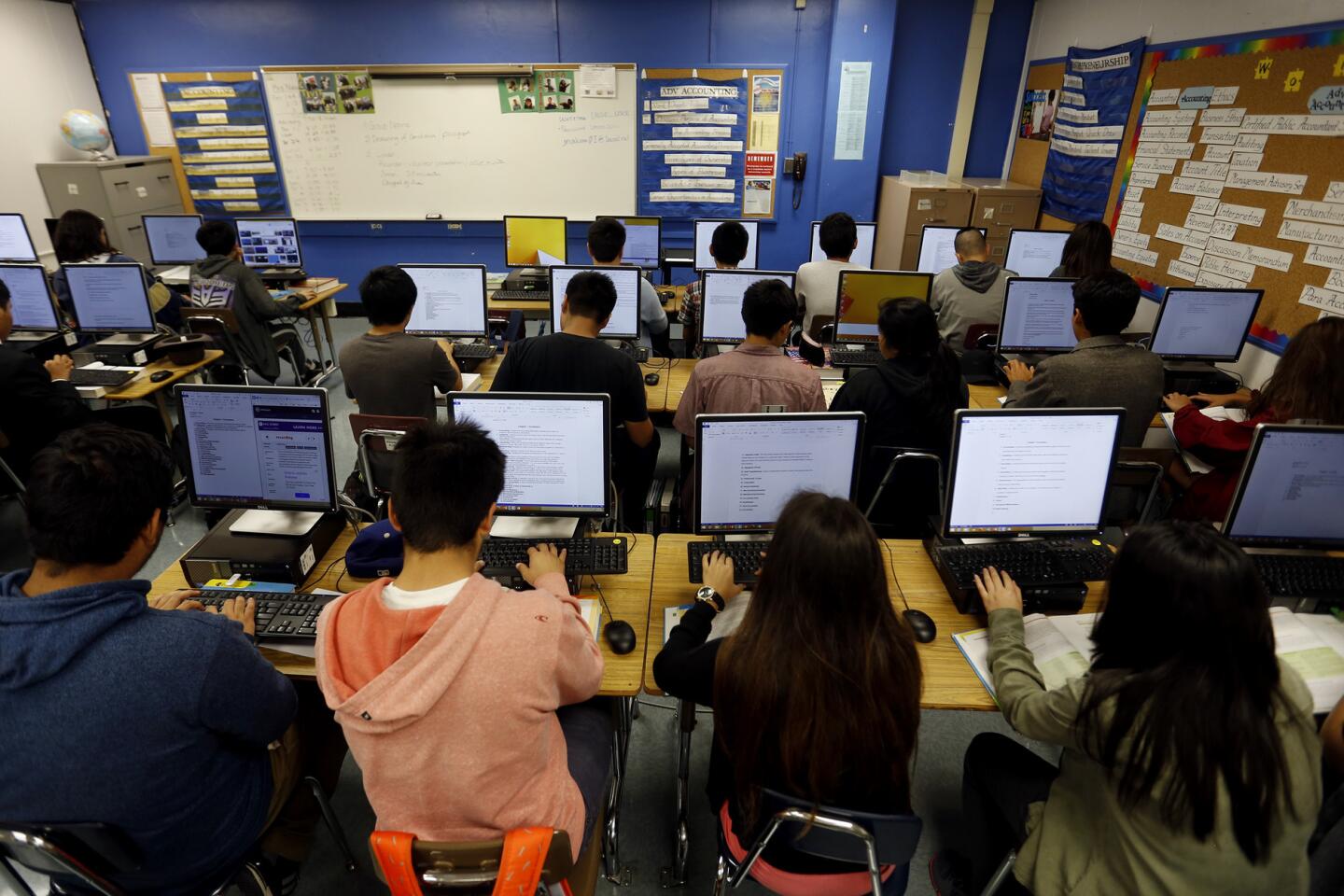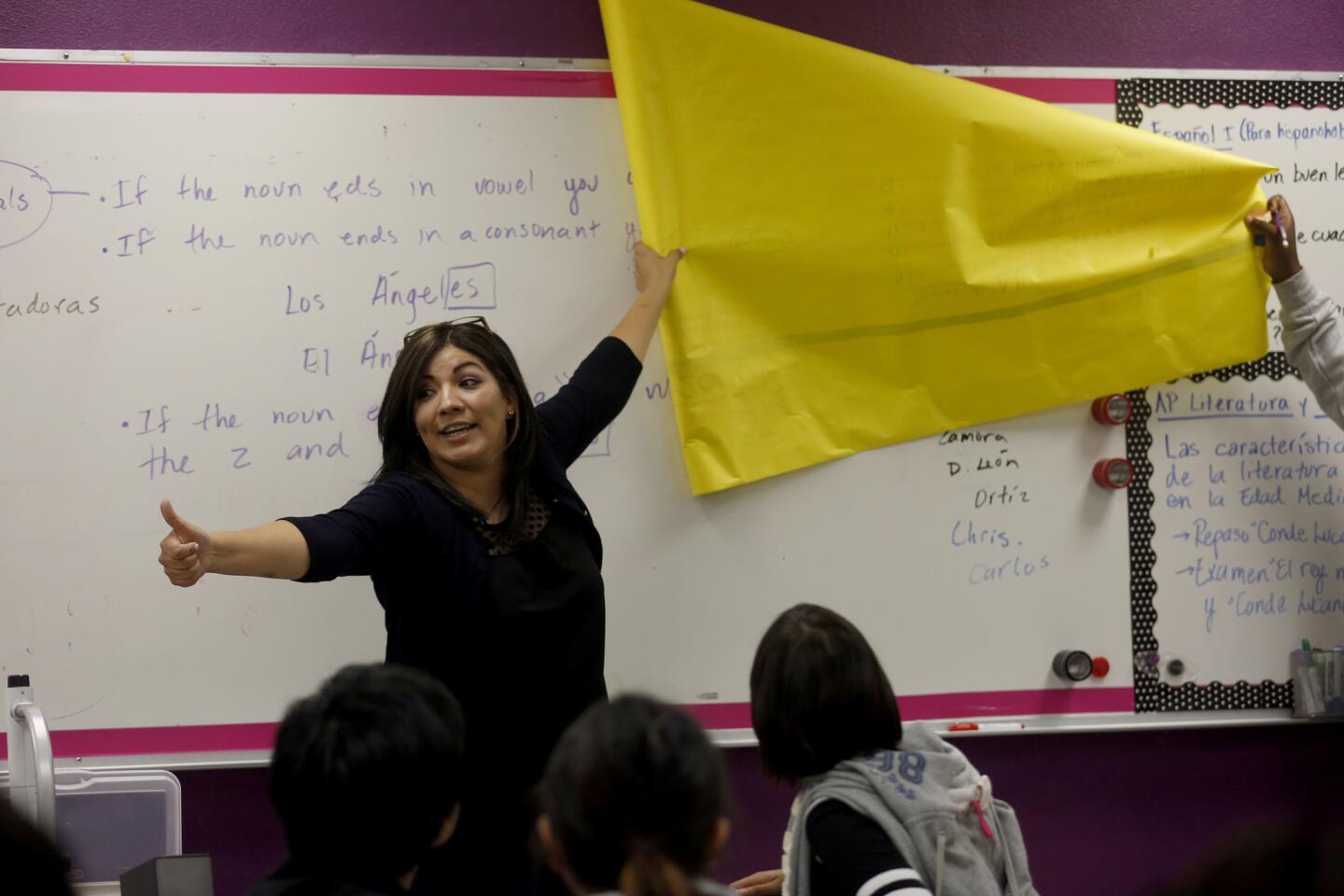California students scored better on this year’s state tests — but fewer than half met college readiness goals
- Share via
If the state’s revamped standardized tests are accurately measuring what they set out to measure, one thing is clear: California has miles to go before all of its students are on an equal footing to face an economy that increasingly demands a college degree and stronger workplace skills.
The good news, if there is good news, is there’s improvement over last year.
This is the second year the test results have been released to the public, and the first allowing for year-to-year comparison. Across the state, 48% of students met English language arts standards and 37% met math standards, according to the test results released Wednesday morning. That compares with 44% in English and 34% in math last year.
That means that more than half of the test-takers in each subject still fell short.
And even with the small improvements, certain groups of students continued to lag especially far behind. Only 18% of black students reached math goals in 2016 — up from 16% last year but still far behind the 67% of Asian students and 53% of white students who reached that standard. Similarly, the percentage of Latinos who reached English goals grew by five points, but at 37% it was still significantly lower than the 73% of Asian students who did.
Students in the Los Angeles Unified School District had lower average scores but increased their scores slightly more than their peers statewide.
In California, 3.2 million public school students — in grades 3 to 8 and 11th grade — took the tests on computers starting in January. Called the California Assessment of Student Performance and Progress, the tests are based on a relatively new set of learning goals called the Common Core.
The standards being measured by the tests are much higher than those of previous state tests, where mere proficiency was enough. They’re supposed to represent the knowledge and skills a student needs in order to be on track for their age to be prepared for college or work after high school.
“We’re setting high goals,” state Supt. of Public Instruction Tom Torlakson said at a news conference Tuesday at Eagle Rock Elementary School in Los Angeles. “High expectations, high hopes, combined with resources, has made a difference.”
“Is this where we want to be?” Torlakson said. “No.”
Many states have adopted the Common Core, or their own slightly edited version of the standards. They are more challenging, and are supposed to emphasize critical thinking and in-depth learning over rote memorization.
“This assessment is much more focused on higher-order thinking skills than the old California test,” said Stanford education professor Linda Darling-Hammond, who helped develop the assessments, which are also known as Smarter Balanced, after the group that created them.
The tests are not supposed to be the sort that teachers can teach to in order to produce high marks — a criticism of previous standardized tests.
One question Darling-Hammond recalled, for example, places the test taker in the position of a congressional staffer whose boss has to vote on whether to build a nuclear power plant. To help the congressman decide, the student-turned-staffer must use the Internet to find evidence for or against nuclear plants, and write a speech or memo using the search results.
Across the state, performance varied dramatically. The top performing districts were wealthy enclaves such as Montecito, San Marino and Cupertino. The Saratoga Union Elementary district in Santa Clara, considered part of Silicon Valley, had top math scores, with 90% of students meeting or exceeding goals.
In the state’s biggest district, Los Angeles Unified, overall standing in both subjects — while showing improvement — remained lower than the state average. Only 39% of L.A. Unified students met English standards and 29% met math standards, up from 33% and 25% last year respectively.
Black students in L.A. Unified had the lowest scores of any racial group and the smallest gains in both subjects, with 18% meeting math standards and 28% meeting English standards.
While some chalk up the educational achievement gap to wealth, poor black and Latino students fared worse on these tests than poor white and Asian students.
“This is shocking. It’s not a pretty picture,” said UCLA education professor Tyrone Howard. “We are not doing an adequate job educating poor kids, black kids, Latino kids.”
Howard said teachers often complain that with ever more rigorous standards, they continue to lack the training or support to teach underserved students effectively or to address the social-emotional issues, such as trauma, that can affect their learning.
The achievement gap, Torlakson said, is real. He said he has created a team to tackle the problem.
English learners also face serious challenges. In California, 13% of these students met English standards and 12% met math standards. In 2015, 11% of English learners met both English and math standards. In 2015-16, there were 1.37 million English learners in California, just over one-fifth of the total public school population.
Analysts say English-learner scores may be low in part because most of the tests are administered solely in English.
“We have a long way to go, particularly in mathematics,” said State Board of Education President Mike Kirst. “The trend is up, but it certainly indicates that we have bigger problems in math than we do in English language arts. Even there, we don’t have as many students college- and career-ready as we should.”
California’s gains were in line with the scores other states have posted, said Jacob Mishook, associate director of assessment and accountability at Achieve, a Washington, D.C.-based nonprofit focused on learning standards. “The results in California are encouraging,” Mishook said.
California, however, needs to invest more in education to raise students’ performance significantly, said Carrie Hahnel, deputy director for research, policy and practice at The Education Trust – West, a nonprofit advocacy group. The state, she said, only recently brought school funding back to pre-recession levels.
Everyone expected scores to go up this year — as is the norm in the second year of a new test, once students are used to the format and technology and teachers are more comfortable with the new learning standards.
The question now is whether scores will continue to increase, Hahnel said, and whether students at the bottom will be able to catch up.
The scores are just one factor that parents can use to assess the progress of the students and the quality of the schools they attend.
The state has recognized that test scores aren’t a definitive measure of school performance, and education officials are working to redefine what a good school looks like. As the State Board of Education irons out details of a new rating system, it’s clear that test scores will be part of a bigger picture that includes factors such as attendance, graduation rates, the rate at which students are learning the English language and the number of suspensions.
Individual scores, which are supposed to be sent home to parents, should not have negative consequences for students. School districts are using them to figure out which students might need extra help — and where — in order to get back on track.
“We’re trying to move away from the punitive, judgment-type approach,” said Alex Rojas, superintendent of the Bassett Unified School District.
The Times analysis varies slightly from official numbers released by the state and some districts. Some test scores vary from official sources due to how decimals are rounded. In addition, The Times includes Filipinos and Pacific Islanders among Asian Americans, even though the groups are accounted for separately by the California government.
Times staff writers Howard Blume and Ben Welsh contributed to this report.
MORE EDUCATION NEWS
Look up how your school scored on the latest California K-12 tests
L.A. Unified finds money to expand health benefits despite budget worries
California’s students beat the national average on the ACT, but huge gaps remain
UPDATES:
12:40 p.m.: This article was updated with comments from state schools Supt. Tom Torlakson.
This article was originally published at 9 a.m.
More to Read
Sign up for Essential California
The most important California stories and recommendations in your inbox every morning.
You may occasionally receive promotional content from the Los Angeles Times.
























